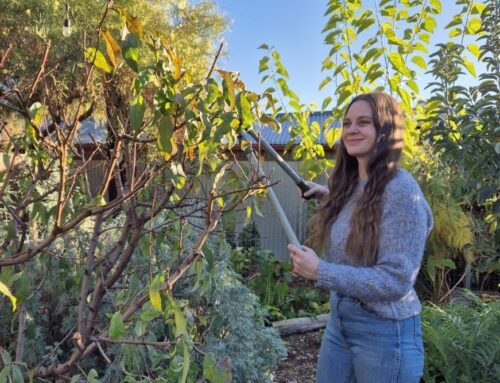
I was asked this question during a recent ABC Radio interview: “Where’s the best place to start when sustainably renovating your home?”
My answer is probably not quite what you’d expect.
So many people seem to rush gung-ho into ripping out their kitchen, completely replacing their bathroom, or building some giant extension.
But I reckon there’s a much more strategic place to start.
Before starting your sustainable home renovations, ask yourself this key question:
What changes will make my home more sustainable and resilient, less reliant on fossil fuels, cheaper to run and healthier for me to live in?
A fancy-arse new kitchen ain’t going to achieve much of that.
But installing solar panels or a couple of rainwater tanks? Now you’re talking.
At my place, I was lucky that both of these elements were already here when I bought. So I focused on passive heating and cooling measures, and changes to improve my indoor air quality.
At my place, I focused on these sustainable renovations first:
- Improving my ceiling insulation and adding door draught stoppers — a passive measure to keep warmth in during winter, and heat out during summer.
- Removing synthetic carpet and vinyl — these types of petrochemical-based furnishings slowly shed microplastics that we breathe in. Gross! I was lucky to have floorboards underneath, which I polished with a modified plant-based oil rather than a polyurethane finish (which also flakes off microplastics). And for rugs, I chose all-natural fibres such as wool, jute and cotton.
- Choosing to paint with ‘enviro’ paint — which has much lower volatile organic compounds (VOCs), which off-gas chemicals into your home for months and possibly even years after repainting. Yuuuuck.
- Installing ceiling fans in almost every room — they help keep me cool in summer but are much cheaper to install and run than air conditioning.
- Adding a combustion fireplace with an oven underneath — so I can warm my home without fossil fuels while using that precious wood energy for both heating and cooking. (In permaculture, this is known as ‘stacking functions’, or getting two or more uses out of one element in your system.)
Meanwhile, my kitchen and bathroom remain untouched. They’re at least 20 years old and aren’t the flashiest. But they’re perfectly functional. Why rip them out, just because?
May I humbly suggest, in this age of climate crisis, that it’s time to choose to be content with what already is within our houses?
As Kirsten Bradley reminds us in the excellent Milkwood Permaculture Living course:
“In most cases, the most eco-friendly item is the one you already have. Every time you buy something new you’re engaging in waste: waste of the old, waste of time, energy, money, water, resources, etc.”
So, forget the grandiose (and incredibly wasteful) ‘flip-it’ style reno — why not instead focus your time and money on smaller and more sustainable changes instead?
PS: Here are a few great resources on sustainable home renovations, that might further help you:
- Renew — a non-profit working to transform Australian homes for climate and energy resilience.
- Sustainable Homes Expert Webinars — an excellent free series running in 2023, covering sustainability and climate-ready homes.
- Retrosuburbia book.
- Earth Restorer’s Guide to Permaculture book.
- ‘How I sustainably renovated my house and saved money too’ — my story for ABC Everyday, if you’re keen to learn more about my own reno.








